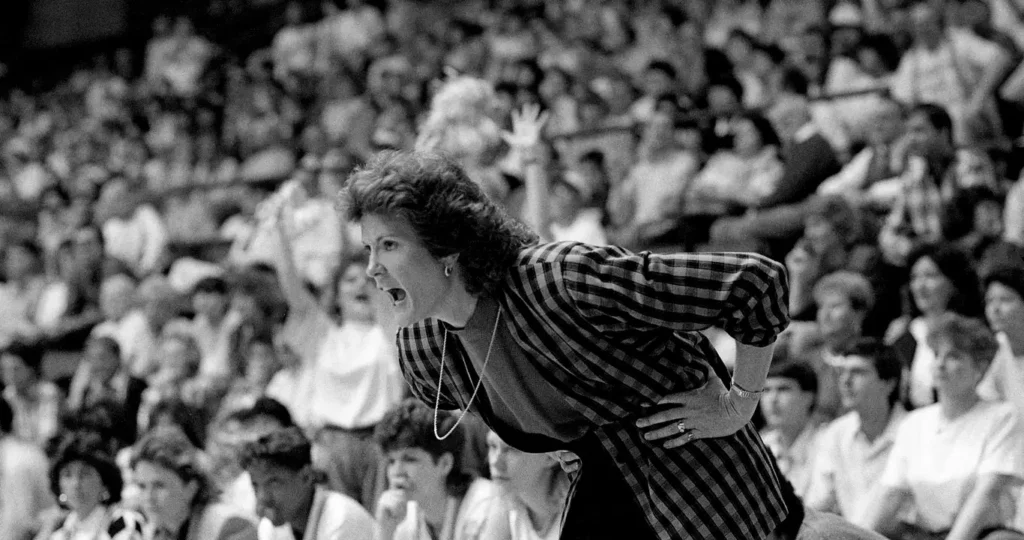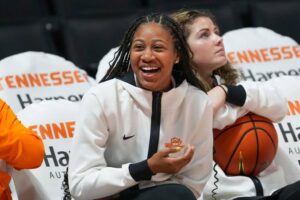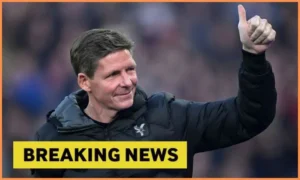
How Pat Summitt Inspired the Trailblazing Women’s Basketball Team of the 1984 Olympics
Trailblazers are rarely forgotten, but sometimes they’re overshadowed. Amidst the fame of Mary Lou Retton, Greg Louganis, Carl Lewis, and Michael Jordan at the 1984 Olympics, the stars of the first gold medal-winning U.S. women’s basketball team were often overlooked.
“Everybody on that team was a star in their own right,” said forward Janice Lawrence Braxton. “We had a team full of stars.”
Legendary Tennessee coach Pat Summitt, who passed away in 2016 at the age of 64 after battling early onset dementia in the form of Alzheimer’s, assembled a roster of phenoms. This included USC’s Cheryl Miller and Pamela McGee, Louisiana Tech’s Kim Mulkey and Lawrence Braxton, Tennessee’s Lea Henry, and Georgia’s Teresa Edwards.
Former Olympian Nancy Lieberman was barred from contention due to her involvement in professional basketball, and she also missed the 1980 Olympics because of the U.S. boycott. However, Pat Summitt shifted her focus overseas, bringing in recent graduates like Anne Donovan, Cathy Boswell, Carol Menken-Schaudt, Denise Curry, Cindy Noble, and Lynette Woodard, who were competing internationally for U.S. national teams.

At just 31, Pat Summitt was already making her mark as a successful coach at Tennessee. She went on to have a legendary coaching career, accumulating eight NCAA national titles, 16 SEC tournament and conference championships, 18 Final Four appearances, and a 1,098-208 record. Widely regarded as one of the best basketball coaches of all time, Summitt was instrumental in shaping the U.S. team into a dominant force at the 1984 Games.
Miller was a standout talent on a team filled with legendary players, serving as the primary scoring option.
After completing her sophomore season at USC before the Olympic trials, she was already a two-time NCAA Tournament champion and Naismith Player of the Year. She would go on to win two more Naismith Awards before beginning her coaching career.
Miller and Summitt were fierce rivals in college, regularly facing off on the biggest stages before joining forces. Miller represented the new generation of basketball players, while Summitt was an old-school coach. Together, after setting aside their differences, they led the national team to its first Olympic gold medal.
The final roster dominated the Olympic field. Summitt instilled a relentless mentality that prevented any moment of weakness. Her coaching, combined with the extraordinary talent she assembled, created an unstoppable force. The team led the tournament in every statistical category, with its smallest margin of victory being a 28-point opening-game demolition of Yugoslavia. The Americans crushed South Korea in the gold-medal game, 85-55.
The players, 40 years later, are shedding light on their journey to immortality:
“Passionate Pat”: Pat Summitt’s intense coaching style and how her players embraced it
How do you transform a group of talented individuals into a cohesive team? Pat Summitt achieved this through intensity, exhaustive preparation, and even some bouts of nausea.
Summitt’s practices were highly competitive, demanding perfection and over-preparation in pursuit of Olympic gold in Los Angeles. Sprints were her preferred method to drive home key points.
“All we did was run,” Teresa Edwards recalled. “Almost the entire team was sick. Trash cans were strategically placed. I still don’t understand why we ran so much.”
Summitt’s coaching approach was unfamiliar to some players, leading to an adjustment period. Janice Lawrence Braxton, who played under Leon Barmore at Louisiana Tech, remembers making a steal in practice and going for an easy layup. Summitt halted the play and chastised Braxton.
” ‘Janice Lawrence, I know Leon Barmore didn’t let you play defense like that,’ ” Braxton recounted Summitt’s words.
However, Summitt’s tough coaching had a purpose. Through shared challenges and countless sprints, a group of competitors became a tightly knit team.
“Because Coach was so tough on us, we had to bond with each other,” Cheryl Miller reflected. “It became us against them, against the coaching staff. That united us.”

The passion, intensity, endurance, and pain—they all paid off. As they celebrated their historic achievement, the players couldn’t help but recall the grueling practices that had forged them.
“I remember receiving our gold medals and feeling relieved that we had made it through,” Braxton said. “That summer was incredibly tough. Pat gave us T-shirts that said, ‘We Survived the Summitt.’ She wasn’t kidding.”
“The anchor”: Cheryl Miller’s once-in-a-generation talent
Summitt aimed to draw out intensity from her players, but with Cheryl Miller, she had to temper it.
“She thought my enthusiasm for the game was showboating,” Miller explained. “My animated style annoyed her.”
After one of their pre-Olympic practices, Summitt confronted Miller about her dramatic on-court demeanor.
“Why are you always so dramatic on the court?” Summitt asked.
“Because the game is dramatic,” Miller responded. “I’m just the exclamation point in the sentence.”
Summitt eventually accepted Miller’s personality, mainly because Miller was undeniably the team’s best all-around player.
Cheryl Miller, a 6-foot-2 forward from USC, had just led her team to a national championship and was already a two-time NCAA Tournament Most Outstanding Player. She topped the Olympic team in points, assists, rebounds, and steals.
“She was ahead of her time,” observed Debbie Antonelli, a former North Carolina State player and current women’s basketball commentator. “She had length and athleticism. She could handle the ball, she was strong. She could dunk, play at the rim, guard anyone. Until Caitlin Clark came along, I thought Cheryl Miller was the best college player ever.”
It’s intriguing to imagine how Miller would fare in today’s game. According to Hall of Fame player Ann Meyers-Drysdale, who competed on the 1976 U.S. Olympic team and called games for ABC in 1984, there’s no need to speculate.
“Could Bill Russell, Oscar Robertson, and Jerry West succeed today? Great players shine in any era,” Meyers-Drysdale affirmed. “Cheryl Miller would undoubtedly thrive in today’s game.”
Miller herself is confident in her abilities in the modern era.
“It’s not boasting,” Miller asserted. “But there’s no player in today’s game where I think, ‘She would have been a challenge.'”
“Fighting for their spot”: The Olympic trials in Colorado Springs
Janice Lawrence Braxton, a senior forward from Louisiana Tech, vividly remembers observing Georgeann Wells at the 1984 Olympic trials. Wells, a 6-foot-7 sophomore from West Virginia who would later become the first woman to dunk in a college game, impressed Braxton with her extraordinary athleticism.
“This girl had arms and legs for days,” Braxton recalled. “She was blocking everyone’s shots at the trials.”
Yet, Wells’ defensive prowess during tryouts wasn’t enough to secure her a spot on the Olympic roster. Braxton saw Wells’ exclusion as indicative of the fierce competition for one of the twelve spots.
“When you play in a certain conference in college, you may not get to see teams from other regions play,” Braxton explained. “But at the Olympic trials, you had players coming from everywhere. It was eye-opening.”
According to Denise Curry, who made the Olympic roster in 1980 but couldn’t compete in Moscow due to the U.S. boycott, the tryouts in 1984 were more competitive due to the presence of collegiate and professional players who were playing internationally.
“The competition was fierce,” Curry affirmed. “The quality of players had increased significantly between the 1980 and 1984 trials.”
Making the 1984 roster remains a cherished memory for Curry.

“I remember sheer joy, just like in 1980,” Curry recalled. “In 1980, they posted the team list on the wall at the Olympic Training Center in Colorado Springs. This time, Pat [Summitt] gathered us in a room and told us individually. In 1984, we didn’t have cell phones, so we scrambled to find a dorm phone to call our families and share the news. It was a mix of relief and overwhelming pride and excitement.”
“Dominance”: Assessing the greatness of the U.S. team
After months of intensive training under Summitt, preparing as if they were underdogs, the team demonstrated their dominance as the favorites.
With a high-pressure defense and fast-paced offense, the Americans overwhelmed every opponent in the group stage, averaging a 33-point margin of victory.
“We knew we had to go out and apply pressure, make it tough for our opponents, prevent them from finding their rhythm or getting into their offense,” Denise Curry explained.
Lynette Woodard, seen here passing the ball to Choi Ae-Yeong during the 1984 Olympic Games, helped the team set a record by leading in all categories at the 1984 Olympics, beating the we records of ? , : Head expectedResult
Here’s a paraphrase of the provided text:
The players, now four decades later, are sharing insights into their path to immortality:
“Passionate Pat”: Pat Summitt’s intense coaching style and its embrace by her players
How do you transform a group of talented individuals into a unified team? Pat Summitt achieved this through intensity, exhaustive preparation, and even bouts of nausea.
Summitt’s practices were highly competitive, demanding perfection and over-preparation to secure Olympic gold in Los Angeles. Sprints were her favored tool to drive home key lessons.
“All we did was run,” Teresa Edwards remembered. “Almost the entire team was sick. Trash cans were everywhere. I still don’t know why we ran so much.”
Summitt’s coaching style was unfamiliar to some players, leading to an adjustment period. Janice Lawrence Braxton, who played under Leon Barmore at Louisiana Tech, recalls making a steal in practice and going for an easy layup. Summitt stopped the play and scolded Braxton.
“‘Janice Lawrence, I know Leon Barmore didn’t let you play defense like that,'” Braxton recalled Summitt shouting at her.
However, Summitt’s tough approach had a purpose. Through shared challenges and countless sprints, a group of competitors became a tightly knit team.
“Because Coach was so tough on us, we had to bond with each other,” Cheryl Miller reflected. “It became us against them, against the coaching staff. That united us.”
The passion, intensity, endurance, and pain—they all paid off. As they celebrated their historic achievement, the players couldn’t help but recall the grueling practices that had forged them.
“I remember receiving our gold medals and feeling relieved that we had made it through,” Braxton said. “That summer was incredibly tough. Pat gave us T-shirts that said, ‘We Survived the Summitt.’ She wasn’t kidding.”
“The anchor”: Cheryl Miller’s once-in-a-generation talent
Summitt aimed to draw out intensity from her players, but with Cheryl Miller, she had to temper it.
“She thought my enthusiasm for the game was showboating,” Miller explained. “My animated style annoyed her.”
After one of their pre-Olympic practices, Summitt confronted Miller about her dramatic on-court demeanor.
“Why are you always so dramatic on the court?” Summitt asked.

“Because the game is dramatic,” Miller responded. “I’m just the exclamation point in the sentence.”
Summitt eventually accepted Miller’s personality, mainly because Miller was undeniably the team’s best all-around player.
Cheryl Miller, a 6-foot-2 forward from USC, had just led her team to a national championship and was already a two-time NCAA Tournament Most Outstanding Player. She topped the Olympic team in points, assists, rebounds, and steals.
“She was ahead of her time,” observed Debbie Antonelli, a former North Carolina State player and current women’s basketball commentator. “She had length and athleticism. She could handle the ball, she was strong. She could dunk, play at the rim, guard anyone. Until Caitlin Clark came along, I thought Cheryl Miller was the best college player ever.”
It’s intriguing to imagine how Miller would fare in today’s game. According to Hall of Fame player Ann Meyers-Drysdale, who competed on the 1976 U.S. Olympic team and called games for ABC in 1984, there’s no need to speculate.
“Could Bill Russell, Oscar Robertson, and Jerry West succeed today? Great players shine in any era,” Meyers-Drysdale affirmed. “Cheryl Miller would undoubtedly thrive in today’s game.”
Miller herself is confident in her abilities in the modern era.
“It’s not boasting,” Miller asserted. “But there’s no player in today’s game where I think, ‘She would have been a challenge.'”
“Fighting for their spot”: The Olympic trials in Colorado Springs
Janice Lawrence Braxton, a senior forward from Louisiana Tech, vividly remembers observing Georgeann Wells at the 1984 Olympic trials. Wells, a 6-foot-7 sophomore from West Virginia who would later become the first woman to dunk in a college game, impressed Braxton with her extraordinary athleticism.
“This girl had arms and legs for days,” Braxton recalled. “She was blocking everyone’s shots at the trials.”
Yet, Wells’ defensive prowess during tryouts wasn’t enough to secure her a spot on the Olympic roster. Braxton saw Wells’ exclusion as indicative of the fierce competition for one of the twelve spots.
“When you play in a certain conference in college, you may not get to see teams from other regions play,” Braxton explained. “But at the Olympic trials, you had players coming from everywhere. It was eye-opening.”
According to Denise Curry, who made the Olympic roster in 1980 but couldn’t compete in Moscow due to the U.S. boycott, the tryouts in 1984 were more competitive due to the presence of collegiate and professional players who were playing internationally.
“The competition was fierce,” Curry affirmed. “The quality of players had increased significantly between the 1980 and 1984 trials.”
Making the 1984 roster remains a cherished memory for Curry.
“I remember sheer joy, just like in 1980,” Curry recalled. “In 1980, they posted the team list on the wall at the Olympic Training Center in Colorado Springs. This time, Pat [Summitt] gathered us in a room and told us individually. In 1984, we didn’t have cell phones, so we scrambled to find a dorm phone to call our families and share the news. It was a mix of relief and overwhelming pride and excitement.”
“Dominance”: Assessing the greatness of the U.S. team
After months of intensive training under Summitt, preparing as if they were underdogs, the team demonstrated their dominance as the favorites.
With a high-pressure defense and fast-paced offense, the Americans overwhelmed every opponent in the group stage, averaging a 33-point margin of victory.
“We knew we had to go out and apply pressure, make it tough for our opponents, prevent them from finding their rhythm or getting into their offense,” Denise Curry explained.
Lynette Woodard, seen here passing the ball to Choi Ae-Yeong during the 1984 Olympic Games, helped the team set a record by leading in all categories at the 1984 Olympics, beating the we






